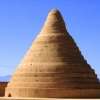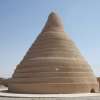About Yakhchal of Abarkuh
Abarkuh Yakhchal is one of the old Yakhchals in Abarkuh that dates back to Qajar dynasty and is situated at the entrance of Abarkuh. It is also known as Abarkuh Entrance Yakhchal which has an interesting mechanism. Abarkuh Yakhchals are historical structures, mainly in possession of noble families and Khans and sometimes built under the command of a benefactor for public use.
Abarkuh Yakhchal was nationally registered in Iran National Monuments with the registration number of 7752.
.jpg)
Architecture of Abarkuh Yakhchal
Abarkuh Yakhchal is a conical structure with a circular map that has been terraced. The perimeter of its dome is 64 m, its height is 22 m, diagonal of its walls is 3 m, and the depth of its store is 4 m. Internal area of its bottom is deeper than surrounding external areas. One of the prominent and main features of Abarkuh Yakhchal is its kind of design and form of structure.
Generally speaking, Yakhchals have 4 main parts including a pond, an ice store, a big dome on the store, and shading walls. The height of most Yakhchals in Yazd province is 20 m which have been built in Qajar dynasty; however, some of which date back to the prosperity of Silk Road and some to Adud al-Dawla (982 - 949).
.jpg)
Used materials in Yakhchal of Abarkuh are stone, mud, raw adobe, lime, and wood. In past, about 50 cm of the Yakhchal was built of cement, stone, lime, and sand. The rest of the Yakhchal was later completed of adobe and mud.
Architects paid attention to the detailed and important points such as type of materials used in the mason, how ice is produced and processed, insulation of the structure, sufficient cooling and frigidity for maintenance and durability of ice. Each Yakhchal has other parts such as ponds for ice processing, a big conical hole that is installed over the big hole, and an adobe dome. The entrance of most of stores in Yakhchals is toward the north, and ice was translocated via a sloped surface connected to the ponds.
Thick conical dome kept the inside air chilly and prevented ice to be melted. According to the scientific theories, warm air tends to go up; therefore, Yakhchals were built with high height in order to keep away warm air from ice stores inside the Yakhchals and prevent ice melting as much as possible. Dome wall at the lower part has a large diagonal and the more it approaches toward the top the less its diagonal becomes. Sometimes the architect terraced or stratified it to lessen the pressure on the dome.
.jpg)
How Yakhchal of Abarkuh work?
Old ice houses or Yakhchals are one of the most interesting and applied patterns of efficiency from green and inexpensive energies that nowadays it would be possible to enjoy from this super benefit with a newer application which is cost-effective economically and environmentally. In the past, for the purpose of constructing a Yakhchal, conical or dome-like adobe monuments were built near a cistern or mountains with abundant snow. Generally, Yakhchals are sign of civilization and used to storing ice.
.jpg)
Mechanism of Abarkuh Yakhchal
There were some ponds built outside of Yakhchals through which water was flown and frozen in winter nights. Then the ice was placed into the Yakhchal. This task was done all the winter nights. Some water was also added to the bulks of ice in order to stick and condense them.
Most of the time, Yakhchals had 2 entrances: one at the north that was used in winters, the other at the south and was used in summers. Ice was put in through small window of the Yakhchal and some dried plants named as “Pizu” were placed on them and window has been closed immediately in order to utilize ice during 3 steps of ice-making, ice-maintaining, and ice-delivering. The person in charge of the Yakhchal used to deliver ice from the southern door to customers. In some occasions when the doors were not used, they were covered with mud and adobe in order to keep the inside air cold.
The most important feature of Yakhchals is application and management of water resources in deserts and xeric and Semi-arid areas in Iran. By constructing such buildings, in addition to lessening the heat and severe thirst in the summers, some appropriate resources have been provided for other seasons, drought times, and possible shortage of water.
Still most of historical Yakhchals have stood firmly and magnificently and attract many visitors. The most ancient Yakhchals in Yazd province date back to Qajar dynasty which are located in Abarkuh, Meybod, and Sadough. Abarkuh Yakhchal and Meybod Yakhchal are more famous than others.
To book Abarkuh Tourism Tour, please click here.
For more information about Yakhchal of Abarkuh, please contact Raadina Support.
Online Support












.jpg)
.jpg)
.jpg)
.jpg)
